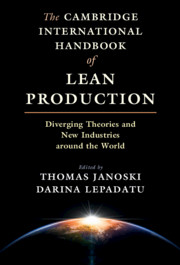 The Cambridge International Handbook of Lean Production
The Cambridge International Handbook of Lean Production Book contents
- The Cambridge International Handbook of Lean Production
- The Cambridge International Handbook of Lean Production
- Copyright page
- Dedication
- Contents
- Tables
- Figures and Sidebars
- Preface
- Acknowledgments
- Contributors
- Abbreviations
- 1 Lean Production as the Dominant Division of Labor
- Part I Theories of Lean Production
- Part II Lean Production across Industries
- Part III Lean Production Around the World
- 17 Lean in Europe and the USA – A New Dominant Division of Labour?
- 18 The Development and Diffusion of the Hyundai Production System
- 19 Transferring Lean to the United States
- 20 Disseminating Lean across the UK: A Personal Reflection
- 21 Lean Production in Germany
- 22 Tricolore
- 23 Lean Production in China: A Case Study of the Automobile Industry
- 24 Lean Production in India and Australia
- 25 The Four Stages of Lean in Mexico
- 26 Lean Production in Post-Communist Europe
- Name Index
- Subject Index
- References
22 - Tricolore
Traditionalists, Taylorists, and Toyotists and the Historical Perspective of Lean in France
from Part III - Lean Production Around the World
Published online by Cambridge University Press: 11 March 2021
- The Cambridge International Handbook of Lean Production
- The Cambridge International Handbook of Lean Production
- Copyright page
- Dedication
- Contents
- Tables
- Figures and Sidebars
- Preface
- Acknowledgments
- Contributors
- Abbreviations
- 1 Lean Production as the Dominant Division of Labor
- Part I Theories of Lean Production
- Part II Lean Production across Industries
- Part III Lean Production Around the World
- 17 Lean in Europe and the USA – A New Dominant Division of Labour?
- 18 The Development and Diffusion of the Hyundai Production System
- 19 Transferring Lean to the United States
- 20 Disseminating Lean across the UK: A Personal Reflection
- 21 Lean Production in Germany
- 22 Tricolore
- 23 Lean Production in China: A Case Study of the Automobile Industry
- 24 Lean Production in India and Australia
- 25 The Four Stages of Lean in Mexico
- 26 Lean Production in Post-Communist Europe
- Name Index
- Subject Index
- References
Summary
Lean development in France reflects in many ways the spread of lean all over the world, with some local specificities. France’s enduring national automotive industry had led very early pioneers to discover Toyota’s uniqueness and appreciate the transformative potential of the Toyota Production System (TPS) well before the term “lean” was coined. French companies then pursued the usual forms of lean, from “automotive” lean, to traditional consulting cost-saving programs disguised as lean, to genuine transformational efforts to understand and adapt the TPS in local conditions. Lean in France has also had some specific French offshoots, such as an obsession with “autonomous teams” and “liberated company” (Getz and Carney 2016), that can be traced to the socio-technical system approach of the Tavistock Institute. More recently, France stands out as the home of several CEOs that have adopted lean as their main business strategy, with very visible results in difficult market conditions and a high labor cost context. Lean and its application in French companies then seems to have become multifaceted, based on continuous and structured learning (Ballé et al. 2006), but also apprehended according to several theoretical frameworks to gradually lead to a richer understanding for researchers (Ballé et al. 2017). This chapter introduces the historical development of lean in France and, through an analysis of lean’s adoption, the three main “lean” perspectives of French companies.
- Type
- Chapter
- Information
- The Cambridge International Handbook of Lean ProductionDiverging Theories and New Industries around the World, pp. 529 - 548Publisher: Cambridge University PressPrint publication year: 2021


